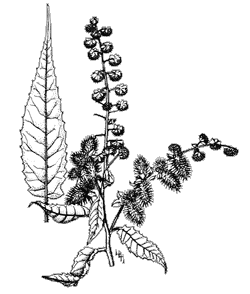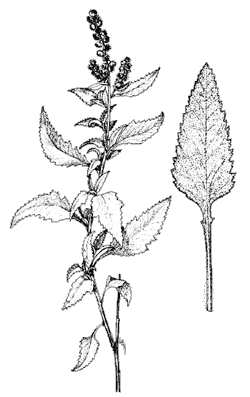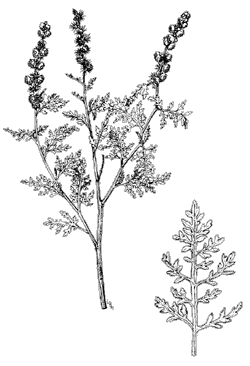Genus Ambrosia
On the surface ambrosias don’t seem to be very interesting. They are wind-pollinated, so they need no animal allies for reproduction. Virtually nothing eats them. And most species are so ordinary in appearance that they are rarely noticed despite their abundance throughout much of our desert. But on closer inspection, these plants reveal themselves to be essential, crucial species of the Sonoran Desert.
Each subdivision of the Sonoran Desert has at least one common species of bursage that contributes subliminally to the visual character of the landscape. The wide range of this group reflects the bursages’ ability to adapt and move into numerous environmental niches. Triangleleaf bursage (Ambrosia deltoidea) grows abundantly among saguaro cacti and palo verde trees where some rain falls in both winter and summer. Canyon ragweed (A. ambrosioides) is a fairly tropical, big-leafed species of somewhat moist habitats that seems to require some summer rain, while white bursage (A. dumosa) rivals creosote bush as the most arid-adapted perennial in North America where rainfall is mostly in winter, and summers are brutally hot. Ambrosia chenopodifolia grows on the mild Pacific coast of Baja California under a winter rainfall regime. Hollyleaf bursage (A. ilicifolia), a bursage with especially attractive foliage, grows in the wetter microhabitats within the hottest, most arid parts of the Sonoran Desert.
Bursages are vitally important to the community as nurse plants. The seedlings of most desert plants cannot survive the extreme environmental conditions in exposed ground; they must start life in the shelter of another (nurse) plant. Bursages are among the few plants that can pioneer exposed sites. Over the following centuries they may be replaced by a series of other species that establish under one another’s canopies. For one possible scenario, imagine a bursage growing today being replaced by another in mid-century, then by a barrel cactus in the 22nd century, a creosote bush in the 23rd, a foothill palo verde in the 26th, and a saguaro in the 27th. Visualize that saguaro producing its first flowers in the year 2670 and you begin to grasp the time-scale on which desert communities function. And here’s hoping you’ll never think of bursages as just drab little allergenic bushes again.
Description
What follows is a general description for the genus Ambrosia. Bursages and ragweeds are mostly inconspicuous shrubs and subshrubs (although some are herbaceous perennials), with tiny to fairly large, usually grayish, leaves. The plants bear inconspicuous staminate (male) and pistillate (female) flower heads on the same plant (monoecious flowering). After pollination by wind, some species (the bursages) develop spiny fruits (burs) which are dispersed when they cling to the fur or feathers of passing animals.
Range
Ambrosia is a mostly American genus of about 24 species, half of which occur in the Sonoran Desert region.
Notes
Despite the abundance of bursages and ragweeds, few vertebrates browse them. Nor do they seem to host many insects; they definitely do not rely on insects for pollination. The copious wind-borne pollen is highly allergenic and a major cause of hay fever.
Ambrosia ambrosioides
English name: canyon ragweed, bursage
Spanish name: chicura
Description
This is a woody shrub to about 6 feet (1.8 m) tall with sparsely-branched, wand-like stems bearing large (to 7 inches, 18 cm long), broad, dark gray-green leaves. It flowers in late winter into spring and occasionally at other times. Though it’s called a ragweed, the fruit is a bur.

Canyon ragweed
(Ambrosia ambrosioides)
Range
Canyon ragweed is a subtropical shrub common throughout Sonora, southwestern Arizona, and the southern half of Baja California. There is also a disjunct population in Durango, Mexico. In the drier parts of its range it occurs mainly in drainages and along roadsides where it receives extra water from runoff. In the northern edge of its range it is restricted to the warmer slopes above valley floors.
Notes
O’odham used canyon ragweed in sweat baths to relieve arthritic pain. They spread hot coals on flat ground and covered them with a layer of ragweed leaves, then laid the afflicted person atop them and covered him or her with a blanket.
Ambrosia deltoidea
English names: triangleleaf bursage, burrobush, rabbitbush
Spanish name: estafiate
Description
Triangleleaf bursage is a densely-branched subshrub to about 2 feet (0.6 m) tall with triangular, finely toothed, gray-green leaves. The leaves are lost in very dry periods. Though it can be confused with brittlebush when not in flower; this bursage is a smaller plant with smaller, duller gray leaves. It flowers from late winter into spring, with burs ripening in late spring.

Triangle-leaf bursage
(Ambrosia deltoidea)
Range
This species is characteristic of Arizona Upland desert, where it is often the dominant understory plant. It also occurs in the eastern portion of the Lower Colorado River Valley subdivision and in a few localities in Baja California.
Notes
This and other bursages are called burrobush and rabbitbush in pollen reports. Don’t confuse it with the plant more commonly called rabbitbrush, Chrysothamnus nauseosus, which flowers only in the fall and is much less allergenic. Bursage is the least ambiguous of the English vernacular names; the others are also applied to unrelated plants. Triangleleaf bursage lives as long as 50 years.
Among the plants sheltered by this bursage is the local pincushion cactus, Mammillaria grahamii. On some rocky bajadas nearly every bursage has several pincushions growing within its modest canopy.
Ambrosia dumosa
English names: white bursage, burro-weed, burrobush
Spanish names: chicurilla, hierba del burro (burro herb), huizapol
Description
This subshrub to about 2 feet (0.6 m) tall has small, white, deeply-divided leaves. Plants are leafless in dry periods, which is most of the year in its habitat. It flowers in late winter to spring, depending on rainfall.

White bursage
(Ambrosia dumosa)
Range
White bursage is common in the driest areas of the Sonoran Desert and southern Mohave Desert. In the parched flats of the Lower Colorado River Valley white bursage and creosote bush are often the only perennial species. In Arizona Upland desert it grows in the fine soils of the valleys; in contrast, triangleleaf bursage grows on rocky or caliche soils.
Notes
Recent research shows that the growth of bursage roots are inhibited by secretions of creosote bush roots. These are the two most common species in the arid valleys of the Lower Colorado River Valley and therefore the most likely competitors for scarce water resources. Perhaps even more interesting is the finding that the roots of different bursage plants seem able to detect one another and respond by growing in different soil volumes. It is likely that many other plants have similar interactions, but we still know very little about what is going on within the soil.